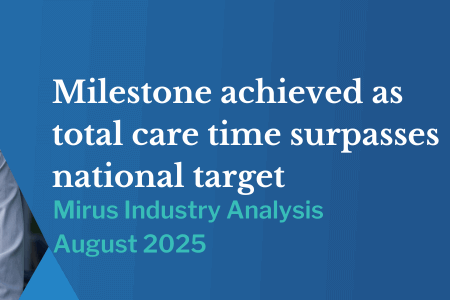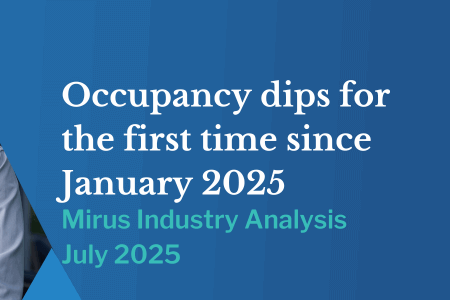Approach to Change Management: The Role of Leadership & Structure in Change Management
May 22, 2025 | Aged Care Management

By guest blogger Victoria Mills, CEO & Founder of Hello Coach
As part of a monthly series for Mirus Mail, Hello Coach sat down with several CEOs working alongside Mirus Australia to explore their experiences, lessons, and wins in embedding change management into their organisations. Throughout this seven-part series, you’ll hear insights from Chris Mamarelis, CEO of Whiddon; Lucy O’Flaherty, CEO of Columbia Aged Care; and Nicole Klason, Executive Director of People and Culture at Newcastle Anglican.
Change is inevitable — but successful change is not. Organisations that thrive through disruption aren’t just lucky. They have two critical ingredients working hand in hand: strong leadership and clear structure.
At Hello Coach, we’ve worked alongside leaders navigating complex transformations, particularly in high-pressure sectors like aged care. Across every success story, two truths stand out:
- Leadership shapes how people feel about change
- Structure shapes how effectively change happens
Without both, even the best intentions can fall short. Let’s take a closer look at why leadership and structure are the true foundations of effective change management.
Keen to share your insights for our next article? Link here for a short survey.
Why Leadership Matters in Change.
At its core, change is a human experience. People must let go of the familiar, adapt to the unknown, and trust that the future will be worth the discomfort.
That’s where leadership comes in. During change, people look to their leaders for four things:
- Clarity: Where are we going? Why are we changing?
- Confidence: Can we do this? Will we be supported?
- Consistency: Will leaders stick to their word?
- Care: Do they see and hear what we’re experiencing?
Leadership behaviours that drive successful change include:
- Visionary thinking: Connecting the change to a bigger, meaningful purpose.
- Authentic communication: Sharing transparently, even when the news is challenging.
- Emotional intelligence: Recognising and responding to the human side of change.
- Visible sponsorship: Staying actively involved—not delegating change to others.
- Resilience and optimism: Modelling calm and determination when setbacks occur.
When leaders lead with both heart and clarity, they create the conditions for trust. Whiddon addressed the importance of leadership by moving the change governance under the CEO’s in order to demonstrate accountability and value.” Trust in leadership is the fuel that powers successful change.
Why Structure Matters in Change
Even the most inspiring leadership can only go so far without the right structure behind it. Change needs a backbone—clear systems, frameworks, and governance—to stay focused, coordinated, and sustainable. Without structure, change initiatives risk becoming:
- Fragmented
- Inconsistent
- Overwhelmed by “business as usual”
- Abandoned before benefits are realised
Structural elements that enable change include:
- Clear governance: Who owns the change? Who is accountable for outcomes?
- Defined processes: How will progress be measured, reported, and supported?
- Resource allocation: Are people, time, and budgets aligned to the priorities?
- Feedback loops: How will teams be heard, and how will we adjust based on their insights?
- Risk management: How are risks identified, triaged, and managed along the way?
Strong structure ensures that change isn’t just announced — it’s embedded.
It gives leaders and teams a shared language, a clear map, and the ability to navigate uncertainty with confidence.
Leadership and Structure: A Powerful Partnership
Leadership without structure is like steering a ship without a rudder. Structure without leadership is like building a ship but leaving it unmanned.
Together, they enable organisations to:
- Align people around a shared purpose
- Empower teams to act with clarity and confidence
- Adapt to feedback, risks, and evolving conditions
- Embed change into the everyday fabric of the organisation
Chris Mamarelis (CEO of Whiddon), Lucy O’Flaherty (CEO of Columbia Aged Care), and Nicole Klason (Executive Director of People and Culture at Newcastle Anglican) all echoed this in recent conversations with Hello Coach.
They found that once change governance moved to the executive level — with structures clearly in place for communication, accountability, and feedback — engagement grew, resistance fell, and adoption improved dramatically.
Our Final Thought
Change is no longer a one-off project. It’s a continuous reality for every organisation that wants to remain relevant and resilient.
To lead change successfully, organisations must invest equally in leadership behaviour and structural discipline. Because when leadership inspires trust—and structure enables action—change doesn’t just happen. It sticks.
And in today’s fast-moving world, that makes all the difference!
Victoria Mills
CEO & Founder Hello Coach


